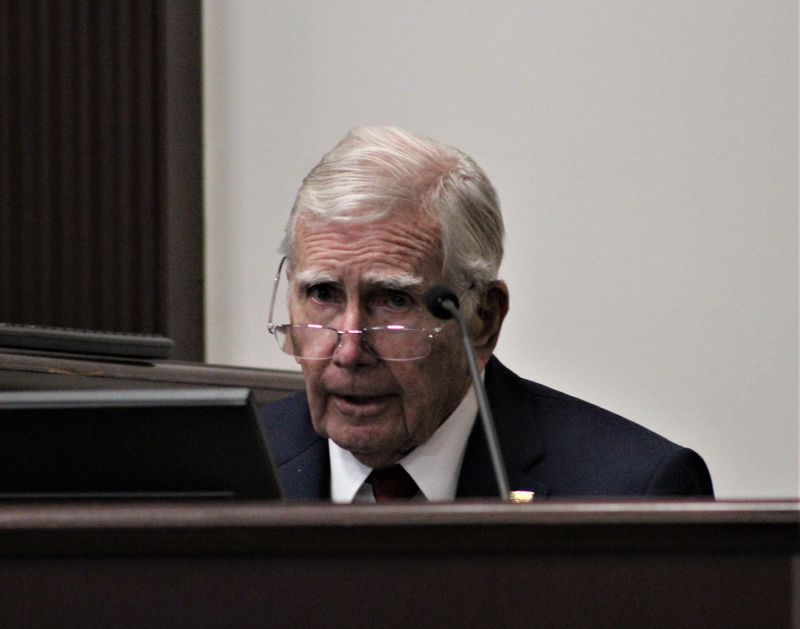DATYONA BEACH — A Daytona Beach serial killer is fighting his conviction and life sentences for killing three women by claiming that his defense attorneys failed to call two witnesses who could have helped him at trial.
Serial killer Robert Tyrone Hayes, 43, was convicted in 2022 of three counts of first-degree premeditated murder in the killings of Laquetta Gunther, Julie Green and Iwana Patton.

Circuit Judge Raul Zambrano sentenced Hayes to three consecutive life terms. A Volusia County jury spared him a possible death sentence.
But Hayes is also awaiting trial in Palm Beach County in a fourth woman’s slaying. And prosecutors there are seeking a death sentence.
Hayes was a criminal justice student at Bethune-Cookman University in Daytona Beach where he played in the college band and was also a cheerleader. He graduated in 2006.
Daytona Beach Police and prosecutors said Hayes killed three women engaged in prostitution in 2005 and 2006. The women were found nude, face down and shot in the head.
Hayes’ case is the topic of a Law&Crime documentary streaming on the A&E network as part of its “Murder on Trial” series. It premiered on Friday, Nov. 21.
Daytona Beach serial killer files motion
Hayes filed a hand-written motion arguing that during trial, his defense attorneys failed to call two women, his girlfriend at the time whom he met at Bethune-Cookman and a roommate. Both have testified that he did not have access to a vehicle at the time of the killings, Hayes said.
Hayes wrote in his motion that Green’s body was found 7 miles from his residence and Patton’s 4 miles away, so he wrote that without a vehicle he could not have transported them to where they were found.
Francis Shea and Christopher Anderson defended Hayes at trial. Shea was the first to testify at the Nov. 24 hearing.
Defense attorney: No mention about vehicle
Assistant State Attorney Andrew Urbanak questioned Shea about Hayes’ claims. Shea said Hayes had mentioned the roommate as a character witness but had not suggested talking to her about a vehicle.“He never mentioned that,” Shea said.
Urbanak asked Shea whether he was present when Hayes’ mother testified that she had provided him a van to use while he attended Bethune-Cookman.
Shea was. And he said that Hayes had junked the van in June or July of 2006, which was after the murders.
Shea also said that tire impressions found on tires at a DeLand junkyard matched those found where Green’s body was located.
Shea said Hayes did not say anything to him about having a van. But Shea said there were other things linking Hayes to a vehicle. Shea said Hayes picked up a prostitute near his residence and paid $75 for a sexual act. He then stole the money from her and she ran down the street nude in Daytona Beach.
Shea also said when Hayes’ former girlfriend, with whom he had a child, was contacted before the trial, she wanted nothing to do with Hayes.
Hayes’ current attorney, Tony Tomas, asked Shea whether there was any investigation into how the vehicle got to the junkyard or who took it there.
Defense says information could have help prosecution
Shea said that if he did have such information, it could have helped the prosecution.
“You don’t want to know every fact. If I know facts that are going to convict Mr. Hayes, I’m not going to want to learn about them, so I didn’t have disclose them to the state,” Shea said.
Tomas asked whether he had investigated further if Hayes had access to a vehicle. Urbanak then objected saying the question was outside the scope of the issue at the hearing.
Circuit Judge Kathryn Weston sustained the objection, meaning Shea did not have to answer.
Hayes’ other former defense attorney, Christopher Anderson, who handled the penalty phase of the trial, also testified.
Anderson said Hayes did not suggest the women as potential witnesses to testify that he did not have a vehicle at the time of the crimes.
Urbanak asked Anderson if he remembered Hayes getting upset during the trial in an issue related to his child. Anderson said he did not, but it would not suprise him and added that Hayes was an emotional and smart man.
But during the penalty phase, Hayes became emotional and clenched his fist when a photo of one of his children was shown on a screen. Zambrano asked jurors to step out of the courtroom and then asked Hayes if he wanted to remain for the rest of the testimony. Hayes said he did but added he did not want any pictures of his children shown.
Hayes did not take the stand and spoke only a few times during the Nov. 24 hearing. Once was when he said Anderson could respond to a question which may embarrass him, if it was beneficial. Anderson then did not respond. Hayes also suggested that the next hearing should be in the afternoon since one of the women testifying lives in California.
The hearing is set to resume on Jan. 9 when the two women are expected to testify.
Daytona Beach serial killer left trail of victims, then case went cold
Gunther’s body was found in an alley off Beach Street on Christmas Day 2005. She was 45.
Green’s body was found on Jan. 14, 2006, off LPGA on the edge of what was then a construction zone but is now the Bayberry Lakes subdivision. Green was 35.
Patton’s body was found on Feb. 24, 2006, in an undeveloped area that is now the entrance to the Daytona Beach Police Department. Patton was 35.
This article originally appeared on The Daytona Beach News-Journal: Daytona Beach serial killer claims defense lawyers were ineffective
Reporting by Frank Fernandez, Daytona Beach News-Journal / The Daytona Beach News-Journal
USA TODAY Network via Reuters Connect





